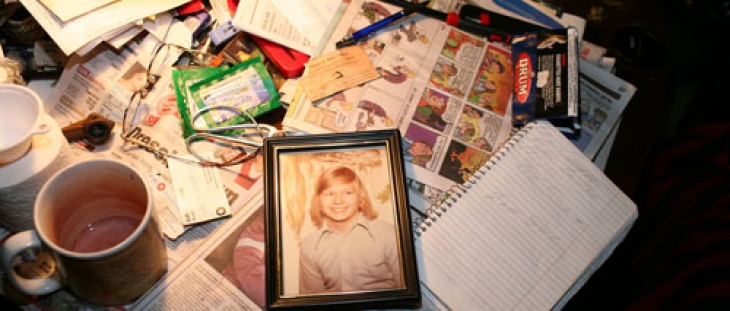
“If you’re almost shitting yourself, then I think we’re doing our job,” says Craig Adams, as I hand him back his phone. I’ve just played through the first part of Sword & Sworcery, an arty, ironic iPhone and iPad game that Adams bills as a “meandering mythopoetic adventure.” The game, in which you take a pixelated avatar on a mysterious quest to the accompaniment of singer-songwriter Jim Guthrie’s ethereal soundtrack, is part of a growing body of work that suggests video games, far from mere distractions meant to tweak the id, can be subtle, wry, even moving experiences. Halo or Call of Duty this is not.
In a moment near the beginning of the game, you direct your blocky and featureless character into an eerie, ancient building. A ghostly, skull-headed figure suddenly begins to chase you and Guthrie’s music ratchets up the intensity. Even on a three-and-a-half-inch screen surrounded by people in a bar, this is surprisingly terror-inducing. But if fear is one part of the experience, it’s far from all of it. Adams describes Sword & Sworcery as a “record you can hang out in,” and the world he’s created is far more alluring than sinister–its landscapes of trees and quasi-Greco architecture look like something Manet may have created had he worked with square pixels rather than paint. And you move your protagonist through the easiest of means, simply pressing on the screen where you want him to go. Adams is the one-man team behind the company Superbrothers.
Along with the Juno-nominated Guthrie, he worked with acclaimed Toronto-based Capybara Games to produce Sword & Sworcery, a title that launched a few weeks ago and which has already become an international sensation. “The initial idea was to make the archetypal video game,” Adams tells me. This isn’t boastful; Adams takes the word archetype rather literally, and Sword & Sworcery distills some of the basic elements that makes interactive art compelling: exploration, otherworldliness and the lure of the unknown. “If you zoom out and look at the whole spectrum of gaming ,” he says, “it seems going into a dark cave with a sword is about as primordial as you can get.” That search for a raw, primal approach has resulted in an experience that relies heavily on atmosphere, mystery and an abstract, retro aesthetic that deliberately leaves much to the imagination.
When your character enters an ominous cave that’s quite literally the mouth of a massive gaping head, it’s clear the game is playing with clichs even as it invokes them to great effect. This kind of experimental approach is starting to become almost de rigueur in Toronto. The city has become one of the centres of indie gaming, producing critical hits like offbeat puzzler Critter Crunch – in which brightly coloured critters vomit rainbows into each others’ mouths – or Jonathan Mak’s experimental Everyday Shooter, which uses guitar notes for sound effects and a psychedelic, completely abstract, style. Like the best indie music acts, indie games tend to be lower budget and fiercely expressive, usually designed by small teams for little or no profit, and tend to push the limits of the form. There’s no single reason Toronto has become a hotbed for this kind of creation, but part of it has to do with a spirit of experimentation that recalls the “Torontopia” of the early 2000s, a grassroots musical renaissance that spawned breakout bands like Broken Social Scene and Final Fantasy.
Toronto’s gaming community has found great success in organizing events called “game jams,” where designers and programmers get together for a few hours or a whole weekend and under intense, often booze-fuelled, conditions create small games so as to practise and improve their skills. The most prominent of these is a weekend-long annual event called T.O. Jam (geddit?) that now has hundreds of participants. Long before these events, word of this growing cottage industry was helped along by “Pleasure Circuit,” an early 2000’s Eye Weekly column by sci-fi writer Jim Munroe that showcased the city’s burgeoning video game community. It was through this column that Adams found out about Jim Guthrie. At the time, Adams was a recent Sheridan art school grad who dabbled in pixel art, a style that took the blocky graphics of nineties video games as its inspiration. Guthrie, meanwhile, was a musician who specialized in quiet, experimental folk, a genre seemingly miles away from Adams’ retro-futurist style.
What captured Adam’s attention was the unorthodox manner in which Guthrie created the backing tracks for his albums. “He had this cheesy MTV Music Maker sequencer program for a Playstation that he picked up for cheap,” Adams says of Guthrie. “And sometimes on tour, he’d just be sitting there with a gamepad, recording music and making these compositions.” Mutual acquaintances soon brought the two together. The fiercely communal, almost incestuous, nature of the city’s gaming scene helped too. Adams met Nathan Vella of Capybara Games at a conference in San Francisco. There, over a few too many drinks, Vella, whose company had achieved some success with Critter Crunch, drunkenly vowed to make a game with Adams. Back (and sober) in Toronto, it still seemed like a good idea, and with some funding from the Ontario Media Development Corporation, they set off to make Sword & Sworcery, which later took on its full title Superbrothers: Sword & Sworcery EP. (A vinyl EP by Guthrie featuring the music from the game will come out shortly after the iPad version releases.)
The advent of the Web has meant that creators no longer need masses of capital to develop, ship and market their creations to Playstation and Xbox owners around the world. As development in technology has seen budgets for mass-market games balloon to tens of millions of dollars, individuals and small teams can digitially distibute their games at a much lower cost, finding dedicated, if smaller, audiences on new platforms like Xbox Live, the Playstation Network and Apple’s App Store. Toronto was in a good position to take advantage of this shift. The lack of any major video game companies in the city meant if you wanted to make games here and had the skill, your only choice to was to go indie. One of the first certifiable indie hits was N+, initially a small Web browser game made by Toronto’s Metanet Software which, when later put on Xbox Live in 2008, sold over a hundred thousand copies–at the time, an unheard of feat for a two-person team.
The situation changed dramatically last year when multibillion dollar French company Ubisoft, makers of the Assassin’s Creed and Splinter Cell franchises, opened an office in the Junction, buoyed by $263 million dollars in grants and tax credits from the Ontario government. Ubisoft is expected to create 800 jobs over 10 years, attracting a growing pool of artists, programmers and designers coming out of Sheridan College and the University of Toronto. Adams is diplomatic about the corporate entrance into the city, suggesting that Ubisoft offers opportunities for talent which previously had no place to go but their own basements. Ubisoft’s deep pockets also means they can afford to take the lead in rekindling the Toronto chapter of the International Game Developers Association, a non-profit member organization that supports game creators. But despite these apparent upsides, the danger of a multinational stepping into a burgeoning scene is the same as it in any other artistic field: given the choice between toiling in a small indie team or working for a big industry player, it’s easy to see which choice many game-makers will make.
Though Toronto has had some breakout indie hits, trying to earn a living making games in the city is still frequently a quick path to poverty. Financial constraints, however, can reap artistic rewards. The blocky, pixel-art style that Adams spent years working on for Sword & Sworcery was an aesthetic borne of economic necessity–it was cheaper and easier to create–but, like the openness of post-rock or the abstract noir of David Lynch, it has the pleasant side effect of demanding far more from its audience. “There is something uniquely expressive about it,” says Adams. “You don’t get quite enough detail in the blank faces, for example, so your mind has to fill in the spaces. I think there’s a certain magic there.”
Playing the game, it’s easy to agree. Everything about it, from the deliberately spare plot to the understated visual style to Guthrie’s soundtrack, which is alternately ambient and then pulsing, speaks to a confidence in gaming as a form capable of more than just straightforward entertainment. This self-assurance is also behind the extra “w” in Sworcery, a winking homage to the stereotypical titles that Adams and other gaming aficionados grew up with but also a playful jab at the conventions of the genre. Such self-awareness suggests a form that’s finally maturing and fulfilling its creative potential. “I hope to appeal to people’s intellects and curiosity,” Adams says, “and reward them with beautiful music and art.”














